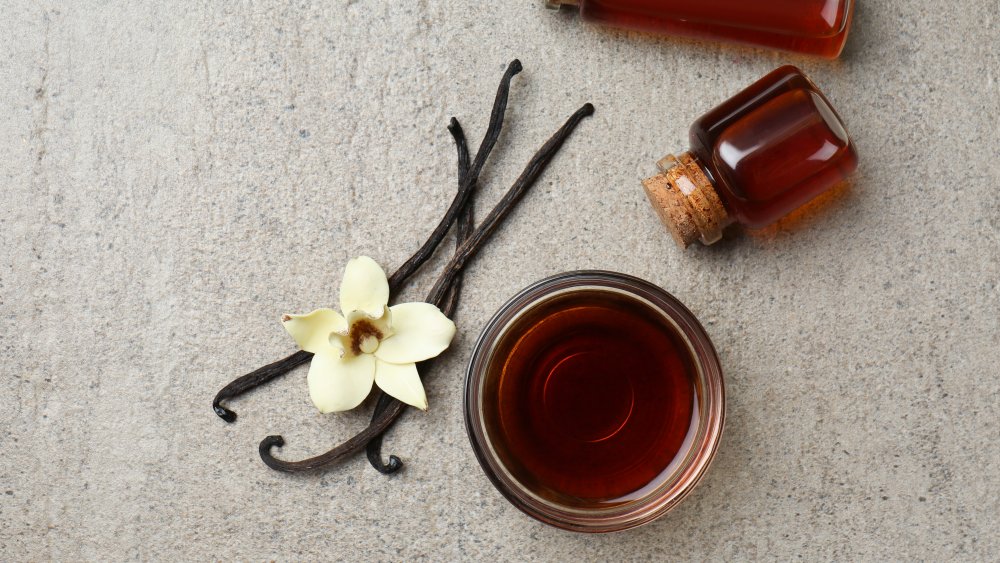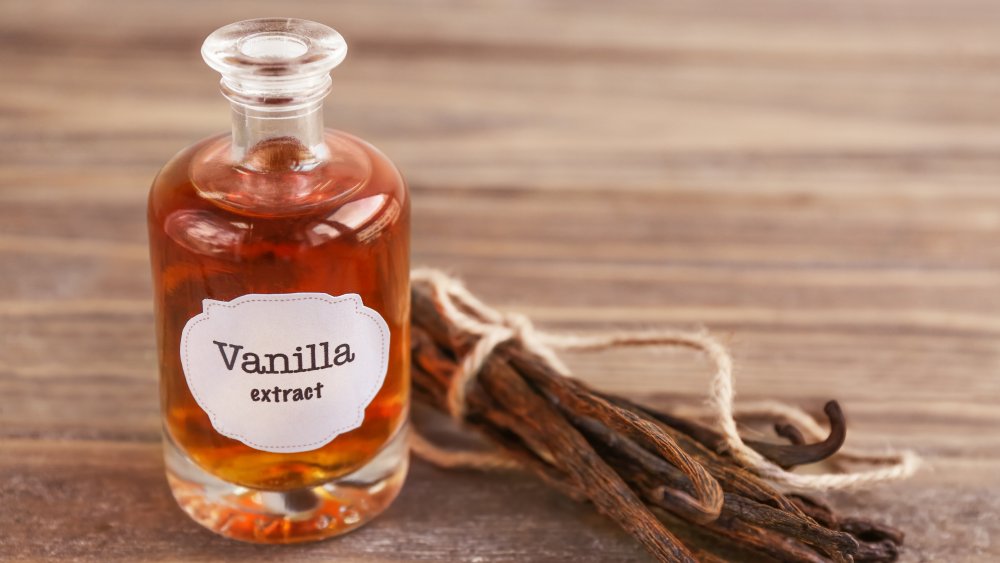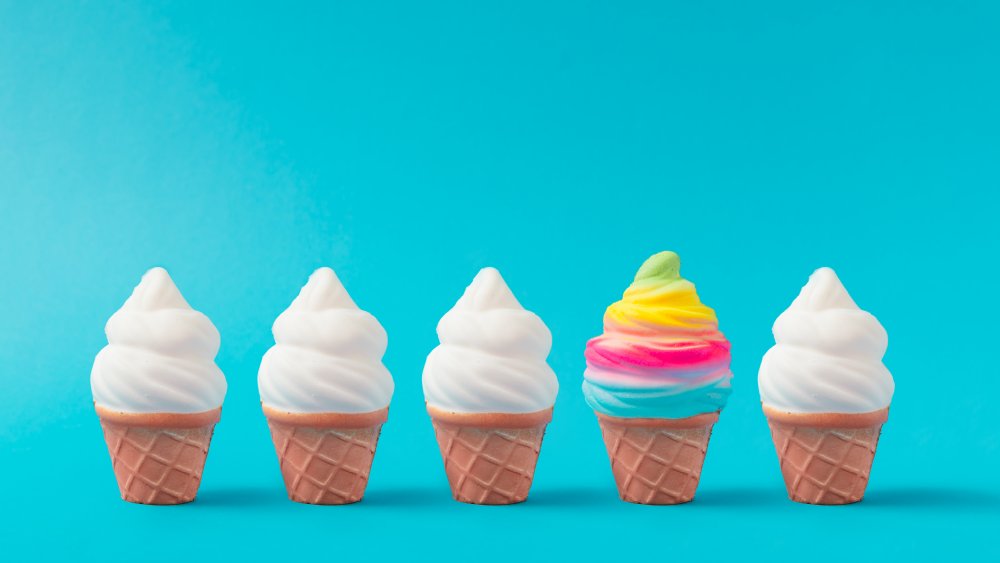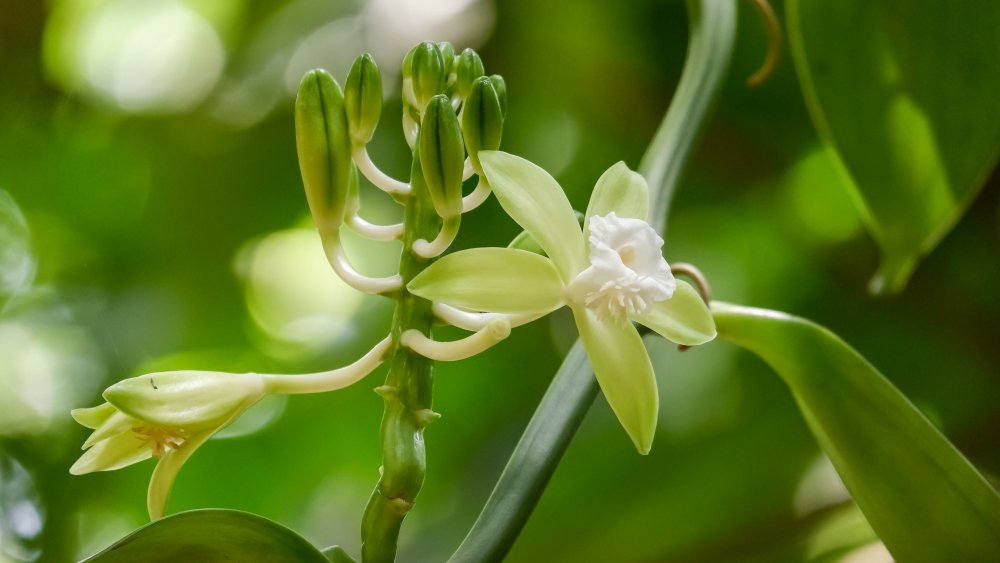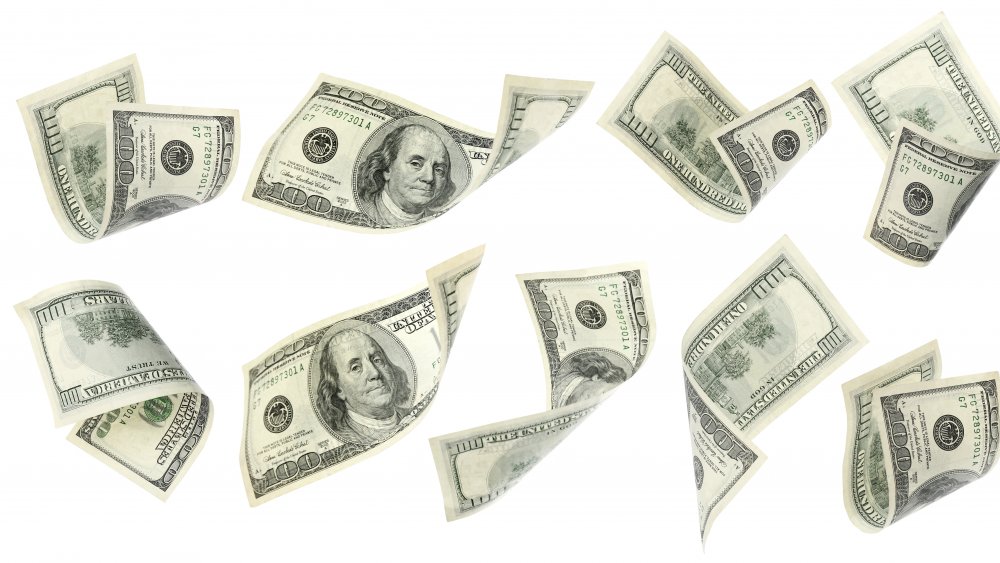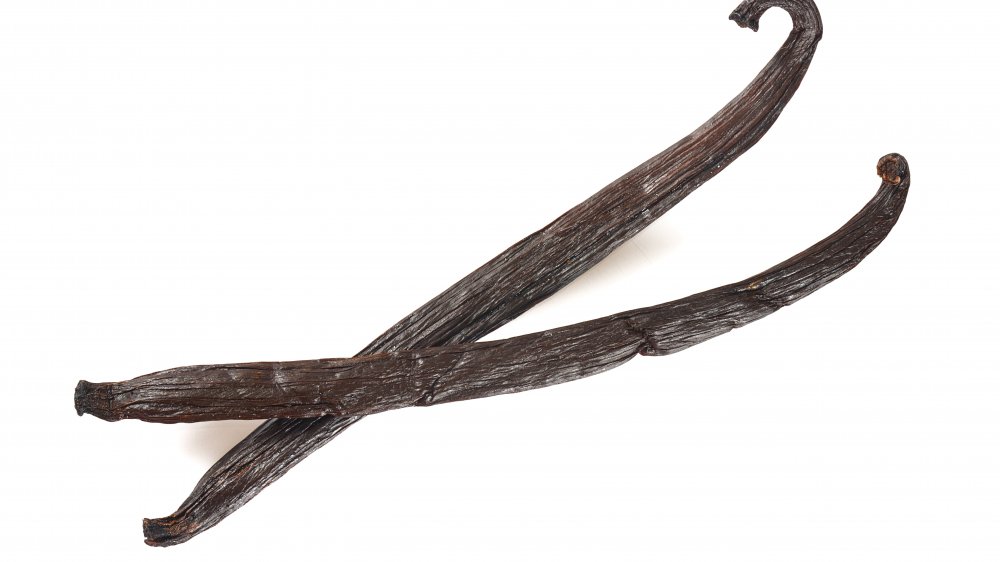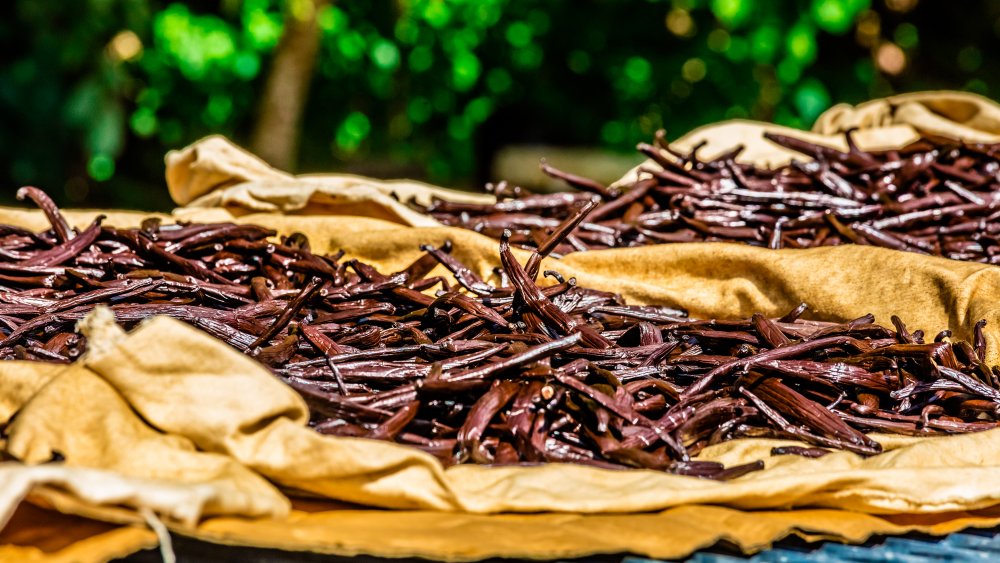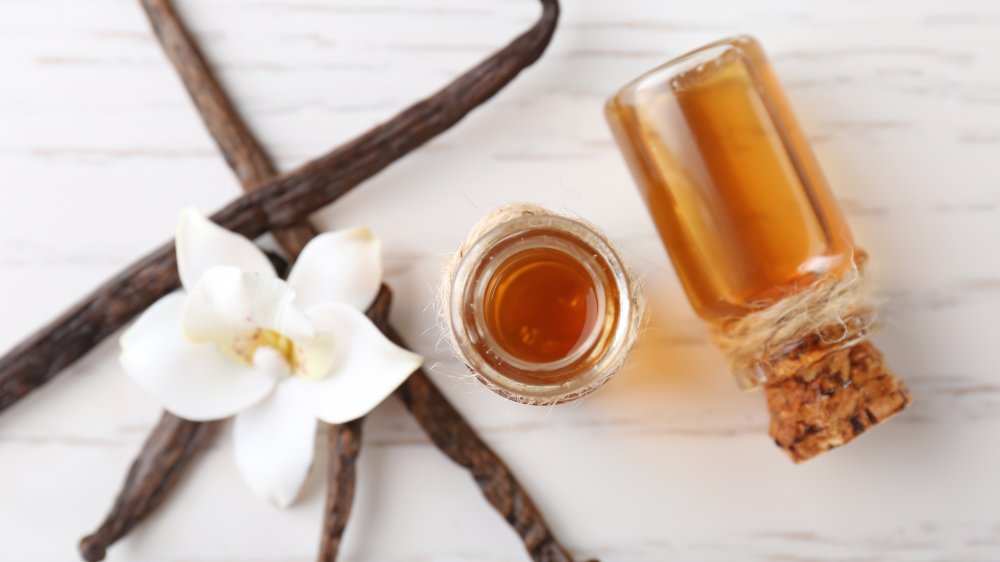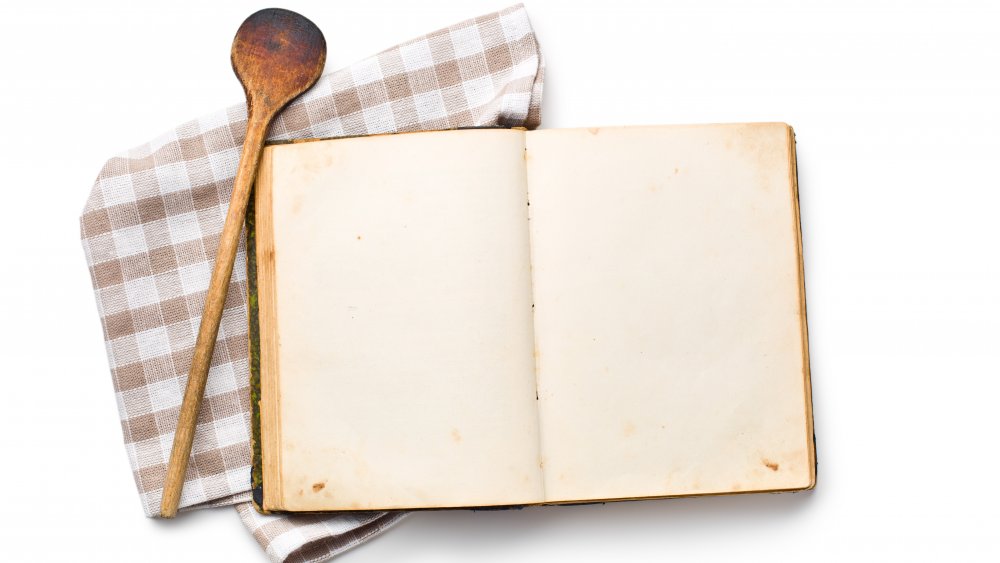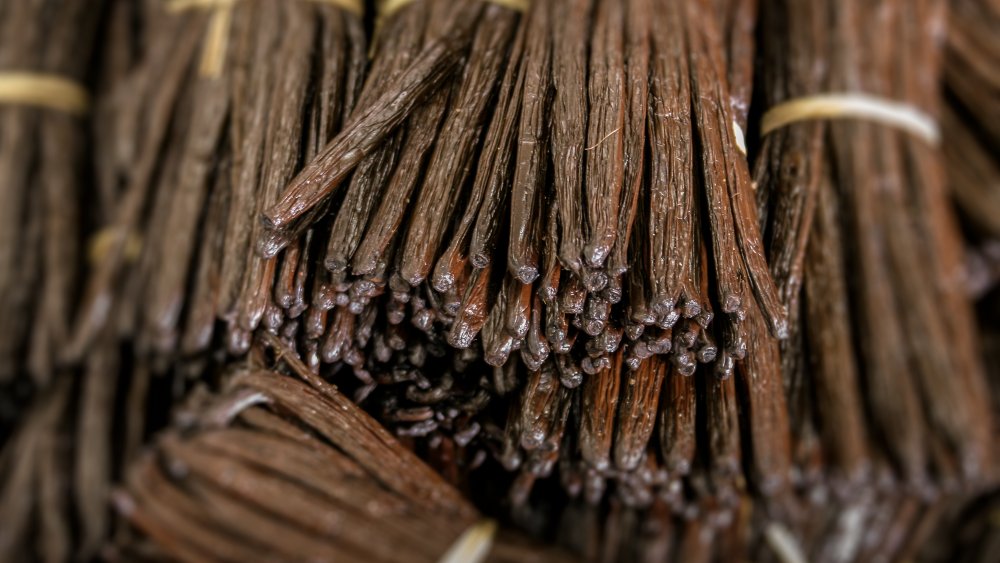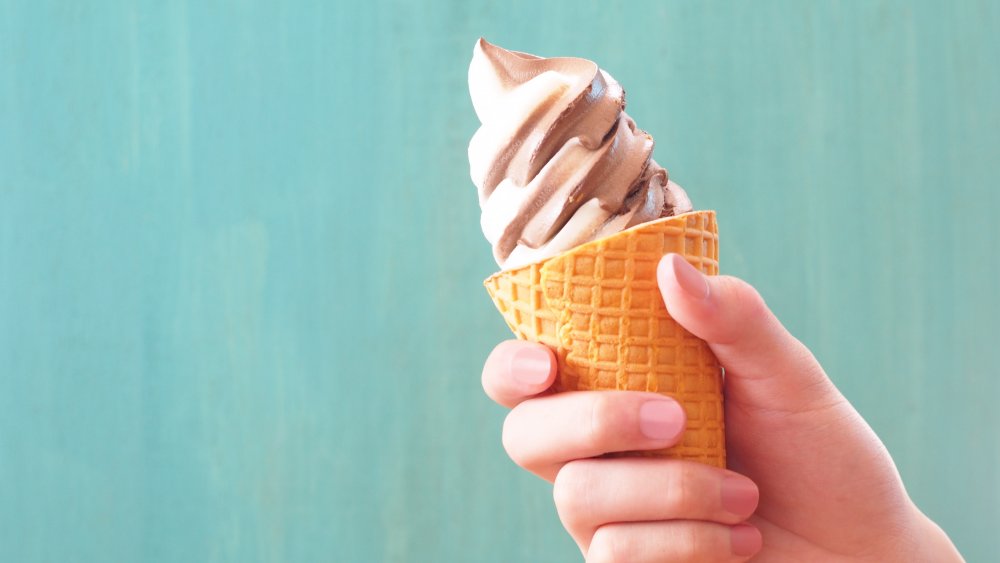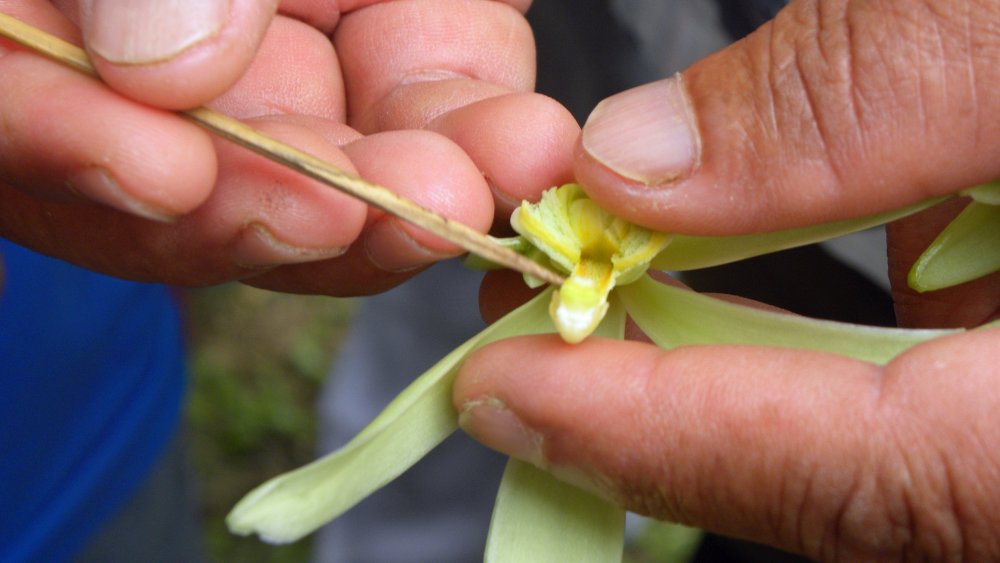Things You Should Know Before Using Another Drop Of Vanilla Extract
Vanilla is loved the world over. It is one of the most popular flavors in the ice cream world, a celebrity among desserts, and a fixture among bakers overall. Vanilla has a warm, woody, floral taste that is exquisite on its own and phenomenal as a supporting ingredient for other flavors. Vanilla is versatile, complex, and well-loved, but vanilla extract, specifically, is actually a relatively finicky ingredient.
Vanilla extract shelves in baking aisles at grocery stores are stuffed with dozens of different options across a wide scale of varying price points, and every vanilla flavoring agent is not created equally. So, what is the difference between different types of vanillas? What makes vanilla Tahitian, or Mexican, or French, or artificial, or all-natural? What makes vanilla extract an "extract" and not a flavoring? A number of legal distinctions, for one, define what it means to be pure vanilla extract. Pure vanilla extract, in the baking world, is the platonic ideal of vanilla flavoring. It's what every vanilla strives to be. Read on to discover exactly why vanilla extract is so sought-after.
Vanilla extract contains hundreds of flavor components
Vanilla is the name for the flavor derived from vanillin, a chemical compound that, when mixed with several other more minor components, results in a beloved ingredient for cooking and baking. Vanilla extract is obtained when the pods of a vanilla plant, also known as vanilla beans, are steeped in alcohol.
In vanilla extract, scientists have discovered hundreds of taste and aroma compounds that layer on top of each other to create the complex flavor of vanilla extract. That said, many of these minor compounds are heat sensitive and ultimately do not make it to the final product of a baking project. That is to say, in part due to vanilla extract's alcoholic nature, between the "cake batter" and "piece of cake" stages of a baked good, much of the vanilla extract components are baked off, resulting in a full, deep vanillin flavor dominating every bite.
Even though much of the extract components bake off, the complex layered flavor of vanilla extract still provides a deeper and more aromatic flavor than simple vanillin flavor.
The FDA has very specific guidelines for vanilla extract
Vanilla extract is specifically the ingredient that results from steeping vanilla beans in alcohol. As such, it is necessary that vanilla extract have those two definitive features: vanilla bean and alcohol. The FDA agrees.
Since 1977, the FDA has mandated that in order for a company to call its product "vanilla extract," the product must contain a minimum of 35 percent ethyl alcohol. That means, yes, drinking pure vanilla extract could get someone pretty drunk, but it could also get that person very, very sick. And that's not only because of the alcohol content.
Pure vanilla extract is also very strongly flavored as per the FDA's specifications. That's important because it means a baker only needs a little bit to go along way. It also means you absolutely should not be drinking pure vanilla extract, ever, although the FDA hopefully doesn't feel the need to specify that.
The vanilla flower only blooms one day per year
Did you know that vanilla extract actually comes from a flower? Specifically, it comes from Vanilla planifolia Andrews and of Vanilla tahitensis Moore, which are members of the orchid family. That means vanilla would make a very pretty decorative plant if harvesting vanilla weren't such a high-stakes and high-profit business.
The vanilla beans, which are technically fruits, start their lives out like all fruits do: as flowers. Interestingly enough, that orchid flower only opens up exactly one day per year, at which point it needs to be pollinated. If it is not pollinated on that day, then that flower will not produce vanilla that year. As it turns out, harvesting vanilla is expensive, labor-intensive, and financially risky. Maybe describing things as "plain vanilla" isn't giving enough credit to vanilla, which is anything but plain when you consider where it comes from.
Vanilla prices have inflated significantly in the past 30 years
In the mid-1990s, if you wanted a pound of vanilla, all you needed was a ten-dollar bill and a decently functional sack, and at the end of the day, you would still have another dollar to spare. But as of 2016, vanilla beans cost nearly $115 per pound. For some sellers, the price is even higher now. While you probably don't need to head to the wholesale store and buy yourself a sack of vanilla, the price inflation of vanilla beans means a price inflation for vanilla extract as well.
Why the whopping price increase? There is certainly an increase in demand for vanilla's deliciously complex flavor profile, but that doesn't account for the full increase. Issues like drought and climate change have made vanilla prices increase as well. And while farmworkers are often woefully underpaid, vanilla pollination remains a labor-intensive process.
Still, a tiny bit of vanilla dried and crushed up can go a long way when steeped in alcohol to create vanilla extract.
Vanilla is the second-most expensive spice in the world
As it turns out, the rapid inflation of vanilla prices adds up. Currently, vanilla is the second-most expensive spice in the world, with prices that can soar as high as $200 per pound or higher. This is largely due to the fact that vanilla is a labor-intensive crop, and drought and climate change have also played a role. Madagascar, where about 80 percent of the world's vanilla comes from, has also seen major storm damage over the past several years, limiting vanilla supply and driving up prices.
Vanilla claims its spot as one of the most expensive spices, right behind the notoriously pricey saffron, which can cost up to $5,000 per pound. In priciness, vanilla lies ahead of another floral pod, cardamom. At around $30 per pound in 2017, cardamom is a steal compared to vanilla and saffron but by no means inexpensive overall.
There really is a difference between all those varieties of vanilla
At the grocery store or in the vanilla ice cream aisle, you can find dozens of names for vanilla: Tahitian vanilla, Mexican vanilla, French vanilla, vanilla bean. There are actually over 150 different kinds of vanilla, and these flavors are not simply a marketing ploy. They have distinct differences.
Mexico is the birthplace of vanilla, and Mexican vanilla comes from Veracruz, Mexico, originally. Madagascar vanilla comes from the same plant, but this plant is populated by hand rather than by a bee, like Mexican vanilla. On a Pacific island in Tahiti, appropriately nicknamed "Vanilla Island," a hybrid vanilla species produces Tahitian vanilla.
In conclusion, there are a number of different species of vanilla plants, pollination strategies for the plant, and production methods for vanilla extract. The climate of every different vanilla-growing region affects the quality of the bean you find at the store.
Vanilla is native to Central America, South America, and the Caribbean
Vanilla is a New World flavor, native to Central and South America. Vanilla was likely first cultivated by the Totonacs, a people indigenous to Mexico. After the Aztecs conquered the Totonacs in the 15th century, they began cultivating vanilla. Later the Spanish colonized the Aztecs and brought vanilla back to Europe.
Soon after vanilla was introduced in Europe, it became an expensive ingredient, often used for flavoring desserts and even chocolate. This concept had originated from the Aztecs, who would use a dash of vanilla to flavor a chocolate drink called chocolatl. Europeans originally balked at this flavor combination but eventually copied it, hoarding both vanilla and chocolate to take back to the Old World. Before long, vanilla became a common import to Europe from America, alongside other supposedly exotic imports such as pineapples, jaguars, and armadillos.
Vanilla ultimately became famous in Europe when an apothecary employee for Queen Elizabeth I invented vanilla-flavored sweetmeats, free of chocolate. They were a hit, and they kicked off more vanilla experimentation among white Europeans.
Vanilla wasn't actually found in any American cookbooks until 1824
Despite its popularity as a flavoring agent for desserts and chocolate, vanilla may not have worked itself into the mainstream until the 1800s. The first time vanilla ice cream appeared in an American cookbook, it was when Mary Randolph published The Virginia Housewife in 1824. Before that, vanilla first appeared in a European cookbook in 1805, when Hannah Glasse suggested adding "vanelas" to chocolate in The Art of Cookery.
But what actually made vanilla commonplace among American consumers may surprise you. In 1886, Coca-Cola joined other American soft drink producers in incorporating vanilla into its products. Above anything else, this normalized vanilla flavoring for Americans, whether they realized it or not. Coca-Cola originally marketed its cola as an "esteemed Brain tonic and Intellectual beverage." Ultimately, this line probably went over better than, "full of vanilla and some alcohol and a surprising amount of caffeine" would have as a marketing slogan.
Less than one percent of the total global market for vanilla actually comes from vanilla beans
The majority of America's market for vanilla flavoring, like more than 99 percent of it, does not actually come from vanilla beans. Technically, this means the majority of vanilla cannot actually be categorized as a "natural ingredient" and must be specified as artificial. Vanilla flavor comes from synthetic vanillin, which may come from a lab environment or from the glands in beavers. Yes, beavers, the animal, produce an artificial vanilla alternative.
According to Scientific American, natural, pure vanilla from vanilla beans has entered a "renaissance" of sorts, as more corporations are pivoting to so-called natural flavoring to meet consumer demand.
Over time, vanilla demand has been unsteady, as consumers at some points have been fine settling for artificial vanilla and at other times are insistent on purchasing the real thing. (To be fair, there is really nothing quite like the real thing.) Other factors, such as price and availability, have also contributed to inconsistencies in consumer demand.
Vanilla is a common flavoring agent in chocolate
Although vanilla and chocolate are positioned as diametrically opposed to each other, one of vanilla's most common uses is as a flavoring agent in chocolate because it works so well at adding depth to sweet flavors. Many chocolate producers will include pure or artificial vanilla in their products. The resulting vanilla flavor in the chocolate is largely undetectable because consumers are so used to vanilla flavoring in chocolate, whether we know it or not. The higher quality the chocolate, the more likely real vanilla is used to flavor it rather than artificial vanilla flavoring.
And it makes sense. Just think about how well these flavors go together. Whether we're talking about mixed chocolate and vanilla ice cream or those bites of chocolate cookie in your Dairy Queen Blizzard, the flavors of chocolate and vanilla just seem to always go hand in hand.
A 12-year-old enslaved boy developed the contemporary method of pollinating vanilla flowers
Until the mid-1800s, vanilla was exclusively pollinated by a specific genus of bee in Mexico. This increased the amount of time it took to pollinate vanilla and led to greater uncertainty regarding whether the vanilla would, in fact, be pollinated in the appropriate timeframe.
That all changed in 1841 when a 12-year-old enslaved boy named Edmond Albius determined that vanilla flowers could be pollinated manually, using a sliver of wood or a small needle. This changed the vanilla industry completely, allowing for vanilla production to increase steeply but requiring significantly more labor from vanilla producers.
To this day, vanilla is pollinated the same way: entirely manually, one by one, by agricultural laborers. This challenging pollination strategy contributes to vanilla's high prices, although Edmond Albius' innovation has made vanilla far more abundant for consumers. And for that, we're definitely grateful.
